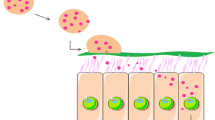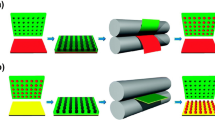ABSTRACT
Purpose
To produce and examine the aerosol performance of protein nano-matrix particles with different surface roughness.
Methods
Aqueous lysozyme solutions were poured into isopropanol during high-shear mixing to produce nanoparticles by precipitation. The size of the nanoparticles was varied by adjusting the precipitation conditions. The resultant suspensions were spray-dried to obtain micron-sized aggregates (nano-matrices). Smooth particles were made by spray-drying a lysozyme solution. The aggregate size distribution, surface roughness, and cohesion were evaluated. The aerosol performance was assessed by dispersing 10 mg of powder from a Rotahaler® at 60 L/min or an Aerolizer® at 100 L/min into a Next Generation Impactor, followed by chemical assay (n = 3).
Results
The median volume diameter and span of the nano-matrix particles were 1.0–1.2 μm and 1.5–1.6, respectively, which were comparable to those of the smooth particles. Surface roughness increased with the size of the primary nanoparticles. The nano-matrix particles were significantly less cohesive than the smooth particles. The fine particle fraction increased linearly with increasing surface roughness and decreasing cohesion.
Conclusions
Nano-matrix particles with controlled surface architecture were successfully produced by spray-drying nanosuspensions. Aerosol performance was enhanced with increasing surface roughness due to the reduction in cohesion forces.




Similar content being viewed by others
REFERENCES
Chan H-K. Dry powder aerosol drug delivery—Opportunities for colloid and surface scientists. Colloids Surf, A. 2006;284–285:50–5.
Patton JS, Byron PR. Inhaling medicines: delivering drugs to the body through the lungs. Nat Rev Drug Discov. 2007;6:67–74.
Clark AR, Stevenson CL, Shire SJ. Formulation of proteins for pulmonary delivery. In: McNally EJ, Hastedt JE, editors. Protein formulation and delivery. New York: Informa Healthcare USA; 2008. p. 219–54.
Gonda I. Targeting by deposition. In: Hickey A, editor. Pharmaceutical inhalation aerosol technology. New York: Marcel Dekker; 2004. p. 65–88.
Hickey AJ, Mansour HM, Telko MJ, Xu Z, Smyth HDC, Mulder T, et al. Physical characterization of component particles included in dry powder inhalers. I. Strategy review and static characteristics. J Pharm Sci. 2007;96:1282–301.
Chan H-K, Clark A, Gonda I, Mumenthaler M, Hsu C. Spray dried powders and powder blends of recombinant human deoxyribonuclease (rhDNase) for aerosol delivery. Pharm Res. 1997;14:431–97.
Chan H-K. Inhalation drug delivery devices and emerging technologies. Expert Opin Ther Pat. 2003;13:1333–43.
Adi H, Traini D, Chan H-K, Young PM. The influence of drug morphology on the aerosolisation efficiency of dry powder inhaler formulations. J Pharm Sci. 2008;97:2780–8.
Adi S, Adi H, Tang P, Traini D, Chan H-K, Young PM. Micro-particle corrugation, adhesion and inhalation aerosol efficiency. Eur J Pharm Sci. 2008;35:12–8.
Chew NYK, Chan H-K. Use of solid corrugated particles enhance powder aerosol performance. Pharm Res. 2001;18:1570–7.
Chew NYK, Tang P, Chan H-K, Raper JA. How much particle surface corrugation is sufficient to improve aerosol performance of powders? Pharm Res. 2005;22:148–52.
Rogueda PGA, Traini D. The nanoscale in pulmonary delivery. Part 2: formulation platforms. Expert Opin Drug Deliv. 2007;4:607–20.
Heyder J, Gebhart J, Rudolf G, Schiller CF, Stahlhofen W. Deposition of particles in the human respiratory tract in the size range 0.005–15 μm. J Aerosol Sci. 1986;17:811–25.
Tsapis N, Bennett D, Jackson B, Weitz DA, Edwards DA. Trojan particles: large porous carriers of nanoparticles for drug delivery. Proc Natl Acad Sci. 2002;99:12001–5.
Hadinoto K, Zhu K, Tan RBH. Drug release study of large hollow nanoparticulate aggregates carrier particles for pulmonary delivery. Int J Pharm. 2007;341:195–206.
Gómez-Gaete C, Fattal E, Silva L, Besnard M, Tsapis N. Dexamethasone acetate encapsulation into Trojan particles. J Control Release. 2008;128:41–9.
Loebenberg R, Finlay WH, Roa WH, Ely L. Effervescent powders for inhalation. US 2007/0031490 A1. 2007.
Ely L, Roa W, Finlay WH, Löbenberg R. Effervescent dry powder for respiratory drug delivery. Eur J Pharm Biopharm. 2007;65:346–53.
Azarmi S, Löbenberg R, Roa WH, Tai S, Finlay WH. Formulation and in vivo evaluation of effervescent inhalable carrier particles for pulmonary delivery of nanoparticles. Drug Dev Ind Pharm. 2008;34:943–7.
Finlay W, Orszanska H. Respirable dried powder formulation comprising drug loaded nanoparticles. WO 2006/130943 A1. 2006.
Azarmi S, Tao X, Chen H, Wang Z, Finlay WH, Löbenberg R, et al. Formulation and cytotoxicity of doxorubicin nanoparticles carried by dry powder aerosol particles. Int J Pharm. 2006;319:155–61.
Finlay WH, Roa W, Loebenberg R. Formulation of powder containing nanoparticles for aerosol delivery to the lungs. US 2005/0019270 A1. 2005.
Bailey MM, Gorman EM, Munson EJ, Berkland C. Pure insulin nanoparticle agglomerates for pulmonary delivery. Langmuir. 2008;24:13614–20.
El-Gendy N, Gorman EM, Munson EJ, Berkland C. Budesonide nanoparticle agglomerates as dry powder aerosols with rapid dissolution. J Pharm Sci. 2009;98:2731–46.
Plumley C, Gorman EM, El-Gendy N, Bybee CR, Munson EJ, Berkland C. Nifedipine nanoparticle agglomeration as a dry powder aerosol formulation strategy. Int J Pharm. 2009;369:136–43.
El-Gendy N, Berkland C. Combination chemotherapeutic dry powder aerosols via controlled nanoparticle agglomeration. Pharm Res. 2009;26:1752–63.
El-Gendy N, Berkland C. Combination nanoparticle agglomerates of fluticasone propionate and albuterol sulphate. In: Dalby RN, Byron PR, Peart J, Suman JD, Farr SJ, Young PM, editors. Respiratory drug delivery 2010. River Grove: Davis Healthcare International; 2010. p. 819–24.
Iskandar F, Lenggoro W, Xia B, Okuyama K. Functional nanostructured silica powders derived from colloidal suspensions by sol spraying. J Nanopart Res. 2001;3:263–70.
Chiou H, Chan H-K, Heng D, Prud’homme RK, Raper JA. A novel production method for inhalable cyclosporine A powders by confined liquid impinging jet precipitation. J Aerosol Sci. 2008;39:500–9.
Chiou H, Li L, Hu T, Chan H-K, Chen J-F, Yun J. Production of salbutamol sulfate for inhalation by high-gravity controlled antisolvent precipitation. Int J Pharm. 2007;331:93–8.
Glover WJ, Wan E, Yun JS, Chen J. A process for making micro-sized protein particles. WO 2009/020434 A1. 2009.
Berkland CJ, Shi L. Nanoclusters for delivery of therapeutics. US 7651770 B2. 2010.
Chen J-F, Zhou M-Y, Shao L, Wang Y-Y, Yun J, Chew NYK, et al. Feasibility of preparing nanodrugs by high-gravity reactive precipitation. Int J Pharm. 2004;269:267–74.
Hu T, Chiou H, Chan H-K, Chen J-F, Yun J. Preparation of inhalable salbutamol sulphate using reactive high gravity controlled precipitation. J Pharm Sci. 2008;97:944–9.
Instruction Manual ULTRA plus Field Emission Scanning Electron Microscope, Carl Zeiss NTS GmBH, Oberkochen, Germany, 2008.
Kumon M, Kwok PCL, Adi H, Heng D, Chan H-K. Can low-dose combination products for inhalation be formulated in single crystalline particles? Eur J Pharm Sci. 2010;40:16–24.
British Pharmacopoeia Appendix XII C, Spottiswoode, London, 2010.
Clark AR, Hollingworth AM. The relationship between powder inhaler resistance and peak inspiratory conditions in healthy volunteers—Implications for in vitro testing. J Aerosol Med. 1993;6:99–110.
Molimard M, Till D, Stenglein S, Singh D, Krummen M. Inhalation devices for long-acting β2-agonists: Efficiency and ease of use of dry powder formoterol inhalers for use by patients with asthma and COPD. Curr Med Res Opin. 2007;23:2405–13.
Srichana T, Martin GP, Marriott C. Dry powder inhalers: the influence of device resistance and powder formulation on drug and lactose deposition in vitro. Eur J Pharm Sci. 1998;7:73–80.
Weiler C, Egen M, Trunk M, Langguth P. Force control and powder dispersibility of spray dried particles for inhalation. J Pharm Sci. 2010;99:303–16.
Heng D, Tang P, Cairney JM, Chan H-K, Cutler DJ, Salama R, et al. Focused-ion-beam milling: a novel approach to probing the interior of particles used for inhalation aerosols. Pharm Res. 2007;24:1608–17.
Adi H, Young PM, Chan H-K, Agus H, Traini D. Co-spray-dried mannitol-ciprofloxacin dry powder inhaler formulation for cystic fibrosis and chronic obstructive pulmonary disease. Eur J Pharm Sci. 2010;40:239–47.
ACKNOWLEDGMENTS
The work was financially supported by the Australian Research Council (Discovery Project 0985367).
Author information
Authors and Affiliations
Corresponding author
Rights and permissions
About this article
Cite this article
Kwok, P.C.L., Tunsirikongkon, A., Glover, W. et al. Formation of Protein Nano-Matrix Particles with Controlled Surface Architecture for Respiratory Drug Delivery. Pharm Res 28, 788–796 (2011). https://doi.org/10.1007/s11095-010-0332-2
Received:
Accepted:
Published:
Issue Date:
DOI: https://doi.org/10.1007/s11095-010-0332-2




